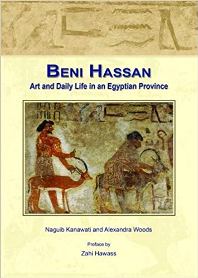
Beni Hasan is an Ancient Egyptian cemetery site. It is located approximately 20 kilometers (12 mi) to the south of modern-day Minya in the region known as Middle Egypt, the area between Asyut and Memphis.
While there are some Old Kingdom burials at the site, it was primarily used during the Middle Kingdom, spanning the 21st to 17th centuries BCE (Middle Bronze Age).
There are 39 ancient tombs here of Middle Kingdom (ca. 21st to 19th centuries BC) nomarchs of the Oryx nome, who governed from Hebenu. Due to the quality of, and distance to the cliffs in the west, these tombs were constructed on the east bank. There is a spatial distribution in this cemetery (there are two cemeteries here: the upper range and the lower necropolis) associated with the different levels of resources available to the deceased; the most important people were buried near the top of the cliff. In the lower cemetery there are 888 shaft tombs, dating to the Middle Kingdom.
In the upper cemetery members of the elite class built striking tombs to represent their social and political positions as the rulers and officials. At this site, the provincial high elite were buried in large and elaborately decorated tombs carved into the limestone cliffs near the provincial capital, located in the upper cemetery area. These tombs lie in a row on a north-south axis. There is a slight break in the natural rock terrace, on to which they open, that divides the thirty-nine high status tombs into two groups. The basic design of these elite tombs was an outer court and a rock-cut pillared room (sometimes referred to as the chapel) in which there was a shaft that led to the burial chamber.
Some of the larger tombs have biographical inscriptions and were painted with scenes of daily life and warfare. They are famous for the quality of their paintings. Nowadays, many of these scenes are in poor condition, though in the 19th century copies were made of several of them.
The first chapter of this study provides an overview of the history and importance of Beni Hassan and highlights the significant architectural features and artistic themes found in the tombs, while the second chapter offers a general description of each of the four selected tombs. The final chapter examines individual artistic themes in the chapels at Beni Hassan and compares the scenes with contemporary tombs as well as those from earlier periods at various sites in Egypt.

